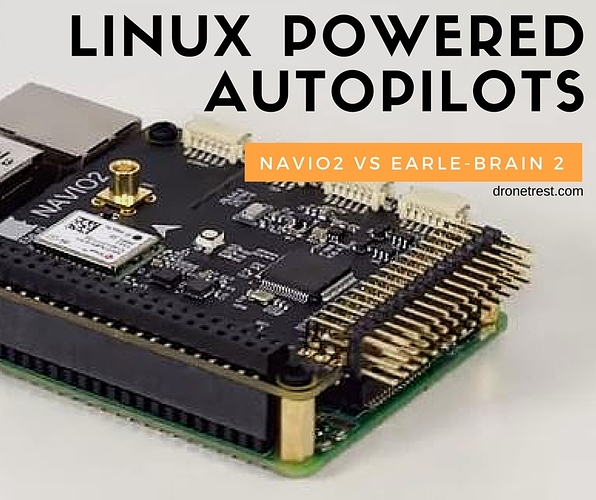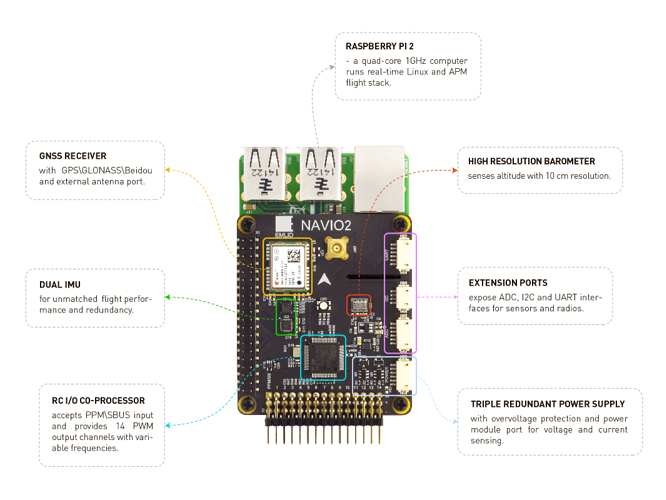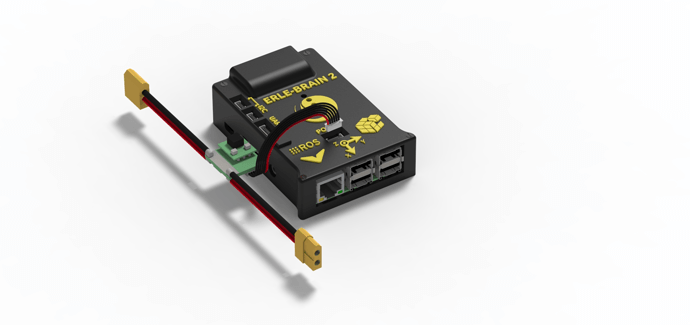The Pixhawk autopilot has provided a great platform and powers thousands of drones today. However it was released almost 3 years ago and has reached the limits in terms of processing power. So if you are looking for a autopilot platform that still uses the same dronecode framework you need to look elsewhere to perform more advanced tasks with your autopilot. This was usually achieved via a companion PC board such as the Odroid, leaving the pixhawk to just perform flight control.
However this last year two new projects have stood out by building a addon board for the raspberry Pi to turn your RPI into a arducopter compatible autopilot with loads more power than Pixhawk. Here we will compare the ERLE-Brain 2 (which is based off the Pixhawk Firecape board) from Erle Robotics in Spain, and the Navio2, from Emild from Latvia/ Hong Kong. However both of these auotpilot boards are also compatible with many other raspberri pi form factor boards such as the more powerful Odroid, or the bannapi and beaglebone single board computers.
What autopilots we compare
Size
Since both the Brain 2 and Navio2 are designed to fit onto your Raspberry Pi 2, the size ans weight are both negligible since the RPI 2 board is the largest and heaviest component. However the Navio is slightly smaller than the Erle-Brain 2.
Sensors
Here the Navio 2 and Erle-Brain 2 use slightly different approaches. The Navio 2, uses two 9 DOF IMU chips. Each chip includes a 3 axis gyroscope, 3 axis accelerometer and a 3 axis compass. On the other hand the Erle Brain 2 uses individual chips, so a 3 axis compass, a 3 axis accelerometer, and a 3 axis gyrocope. The advantage of having separate IMU sensors is that they are typically more sensitive as they are larger (do not need to cram 3 sensors into 1 chip. Hoever since the Navio2 uses two 9DOF IMU chips I am sure that both autopilot system will perform flawlessly in all robotics applications. You also have the option to change the scale of the IMU sensors, so if you are using your autopilot in high g force environments you can set the scale to $\pm$16G. However when you increase the scale, the actual sensitivity reduces.
Powering the autopilot
Both the boards make use of the APM power module to provide power to the board, and also to provide current and battery monitoring functionality.
Price
The Navio2 is sold for 190 USD, the board itself is 168, but you will need to also order the GPS antenna for an additional 12. Since the Navio2 has the GPS chip onboard you dont need to add a GPS module, but you will need to include the antenna. This brings the basic cost excluding the Raspberry Pi to 190USD. Adding a raspberry pi, and an APM power module and converting to GBP, the total cost of a Navio2 autopilot will be about £175 (not counting any VAT or possible import duties)
The Erle-Brain 2 on the other hand is only sold as a complete kit with the Raspberry Pi for 199.00€ excluding VAT. It does not include a GPS module out of the box you will need to add that, however since it uses the same UART and I2C connectors you can use any GPS module compatible with the pixhawk with the brain 2. So lets say we use a Ublox Neo 7 GPS module (£30), and converting the total to GPB, we come in at around £180.
Documentation
Since the Navio 2 is a new product, there is little documentation as of me writing this article, however in terms of the documentation available for the Navio+ (the predecessor to the Navio2) I would say that their documentation is a little easier to follow from a beginners point of view. So hopefully within a month or so the Navio2 documentation will be released.
Conclusions
So at the end of the day, both these options are very similar in terms of hardware, the only thing that will set these apart is the support offered by each manufacturer, and only time will tell. So far Navio2 does seem to be more popular currently. However with the release of the PXFmini from Erle robotics, they are now offering a much smaller autopilot board, which I imagine will turn into the Erle-Brain 3, which allows you to run your autopilot on the new raspberry Pi Zero (but its also compatible with raspberry Pi 2, and Odroid if you need more processing power) which could be a very good reason to switch to the smaller platform.
This is article I was just thinking out aloud in case anyone was wondering the same questions as me, so some things could be wrong, or outdated. If you do have any specific questions or corrections just let me know below.


